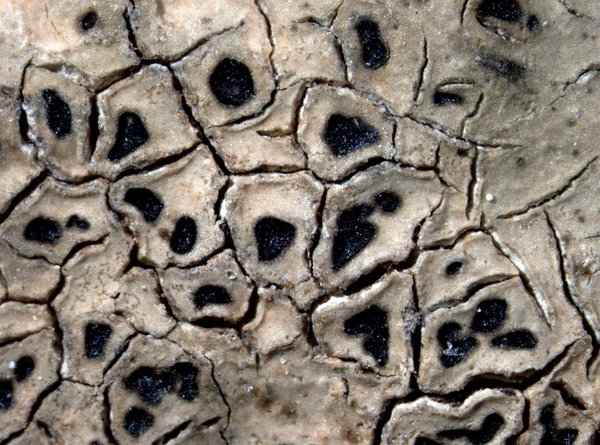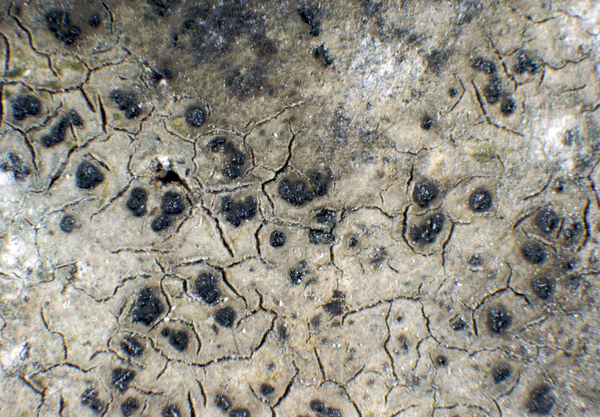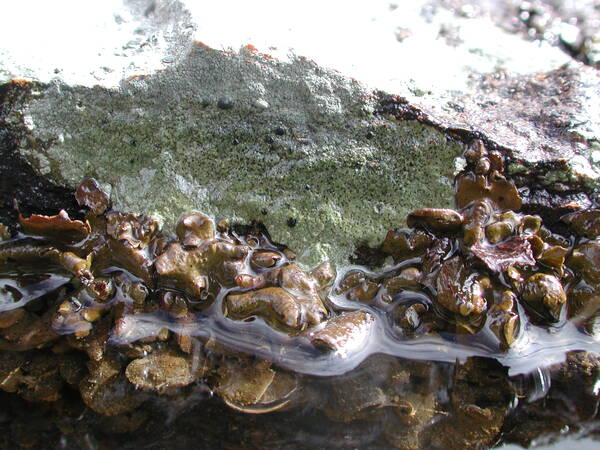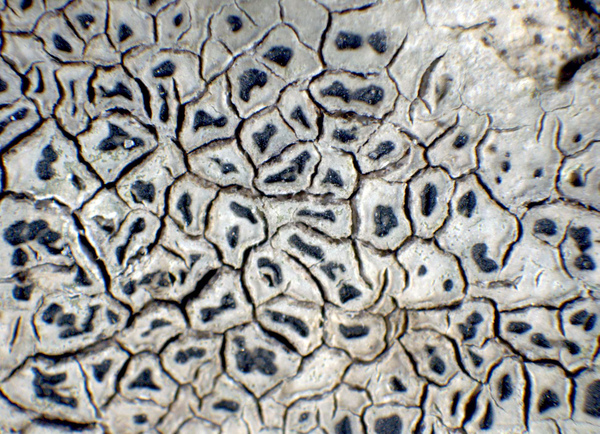Aspicilia aquatica (Fr.) Körb.
Syst. Lich. Germ.: 165, 1855. Basionym: Parmelia cinerea var. aquatica Fr. - Lich. Eur. Ref.: 144, 1831.
Synonyms: Aspicilia eluta (Nyl.) Hue; Aspicilia flageyi Hue; Aspicilia griseopallida (Vain.) Hue; Lecanora amphibola sensu Vain.; Lecanora aquatica (Fr.) Hepp; Lecanora flageyi (Hue) Zahlbr.; Lecanora mazarina (Wahlenb.) H. Magn.; Lecanora rivulorum H. Magn.; Zeora cinerea var. aquatica (Fr.) Flot.
Distribution: N - TAA (Nascimbene & al. 2007b), Lomb, Piem (Isocrono & al. 2004), Emil, Lig. C - Tosc, Marc, Abr, Sar (Nascimbene & al. 2023). S - Camp, Bas, Cal (Puntillo 1996).
Description: Thallus crustose, episubstratic, rimose-areolate, 0.2-0.4(-0.6) mm thick (usually less), smooth, whitish grey to blue-grey, often with a yellowish or greenish tinge, forming up to 10(-15) cm wide patches, sometimes delimited by a narrow dark prothallus. Areoles angular to round, flat to slightly convex, 0.4-1(-2) mm wide, contiguous. Cortex 20-40 µm thick, of anticlinally arranged cells, the uppermost part brownish, covered with a thin epinecral layer; algal layer not extending below the hypothecium; medulla white, I-. Apothecia lecanorine-aspicilioid, (0.1-)0.2-0.5(-1) mm across, immersed, 1-2(-4) per areole, round to rarely angular, with a black, epruinose, usually concave disc often surrounded by a darker proper margin, and a thin thalline margin. Exciple (20-)40-60(-70) µm wide, the uppermost cells brown; epithecium green to olive, N+ emerald green; hymenium colourless, (110-)130-200(-250) µm high, I+ blue turning red-brown; paraphyses branched, submoniliform, 1.5-2(-2.5) µm thick at mid-level, the apical cells 3-5 µm wide; hypothecium more or less colourless, (30-)40-60(-70) µm high, I+ blue. Asci 8-spored, cylindrical-clavate, the thin outer coat K/I+ blue, the wall and apical dome K/I-. Ascospores 1-celled, hyaline, ellipsoid to broadly ellipsoid, (17-)20-28(-35) x (10-)13-19(-20) µm, thin-walled. Pycnidia 1(-2) per areole, with a black to brown, punctiform ostiole. Conidia filiform, straight or slightly curved, 12-18(-25) x 0.8-1.2 µm. Photobiont chlorococcoid. Spot tests: cortex and medulla K-, C-, KC-, P-, UV-. Chemistry: thallus without lichen substances.
Note: a probably holarctic species of periodically submerged rocks, also present in montane Mediterranean rivulets which are dry during summer.
Growth form: Crustose
Substrata: rocks
Photobiont: green algae other than Trentepohlia
Reproductive strategy: mainly sexual
Periodically submerged (e.g. in creeks)
Commonnes-rarity: (info)
Alpine belt: very rare
Subalpine belt: rare
Oromediterranean belt: very rare
Montane belt: rather common
Submediterranean belt: extremely rare
Padanian area: absent
Humid submediterranean belt: very rare
Humid mediterranean belt: extremely rare
Dry mediterranean belt: absent

Predictive model
Herbarium samples
Growth form: Crustose
Substrata: rocks
Photobiont: green algae other than Trentepohlia
Reproductive strategy: mainly sexual
Periodically submerged (e.g. in creeks)
Commonnes-rarity: (info)
Alpine belt: very rare
Subalpine belt: rare
Oromediterranean belt: very rare
Montane belt: rather common
Submediterranean belt: extremely rare
Padanian area: absent
Humid submediterranean belt: very rare
Humid mediterranean belt: extremely rare
Dry mediterranean belt: absent

Predictive model
| Herbarium samples |
 INDEX FUNGORUM
INDEX FUNGORUM
 GBIF
GBIF
 DOLICHENS
DOLICHENS








